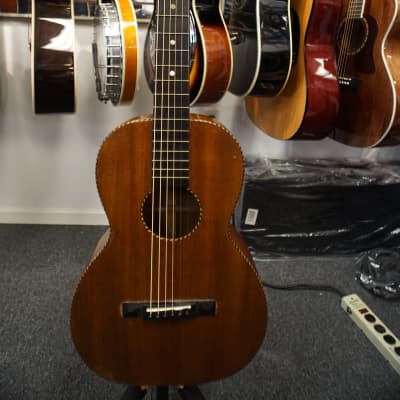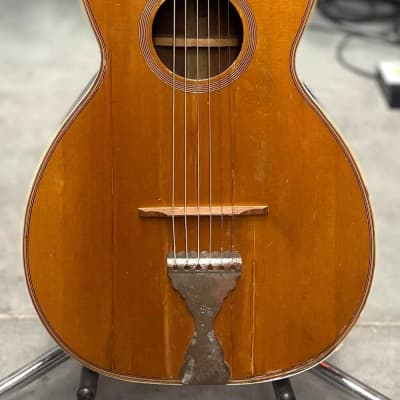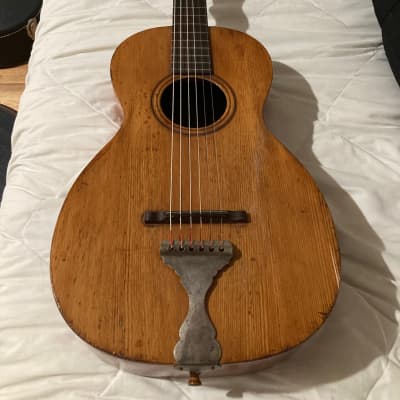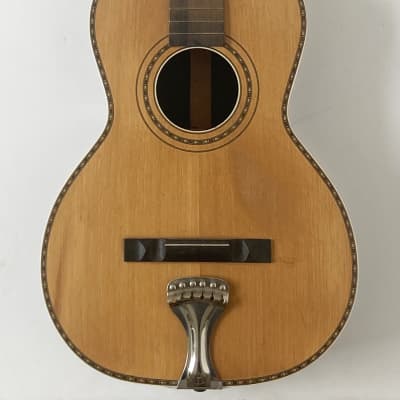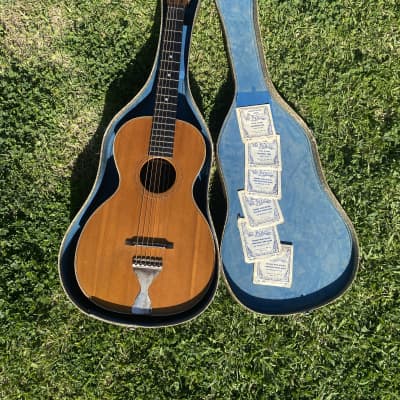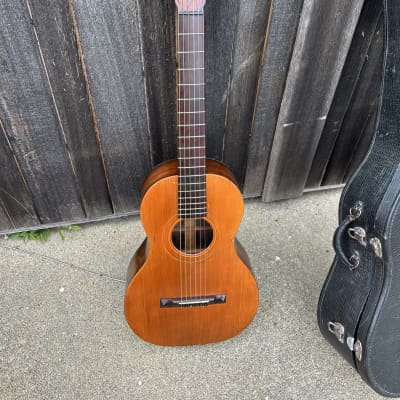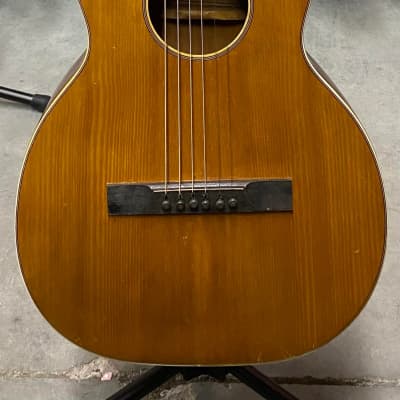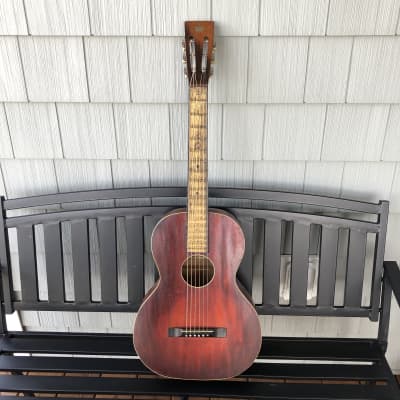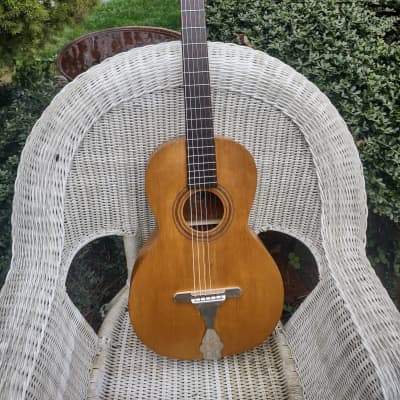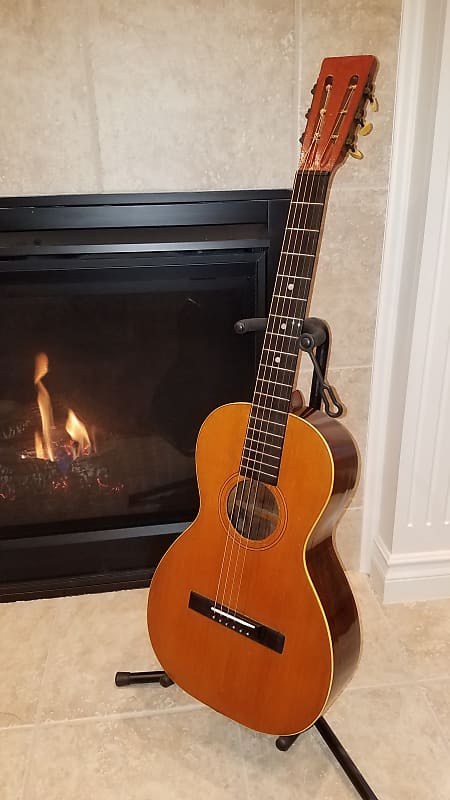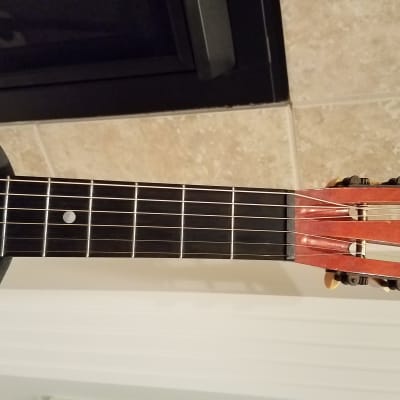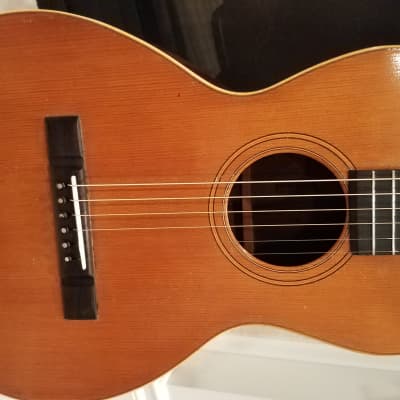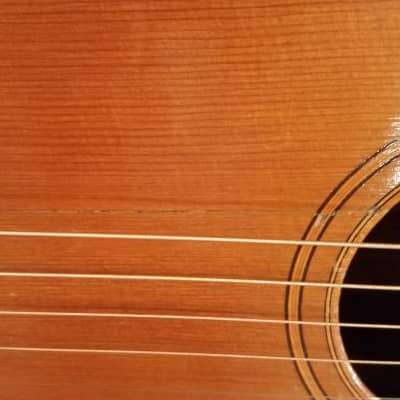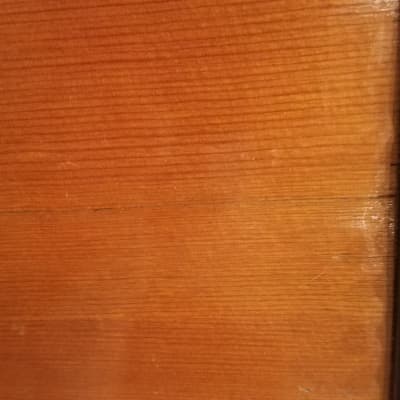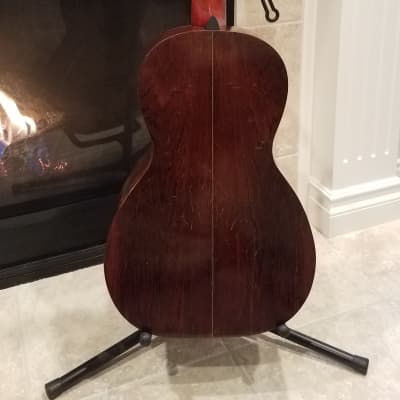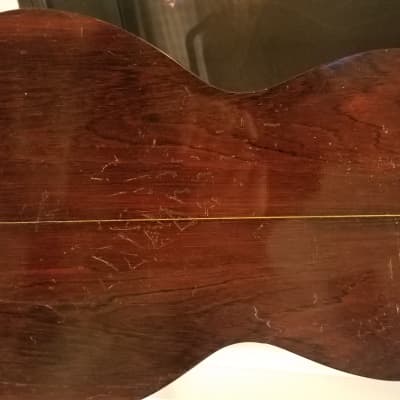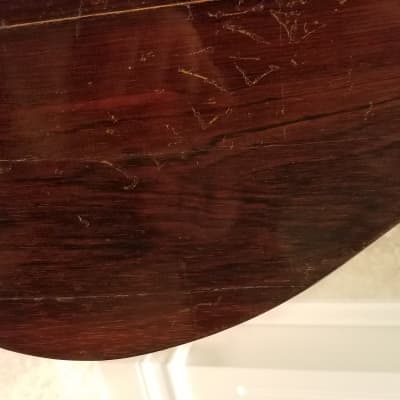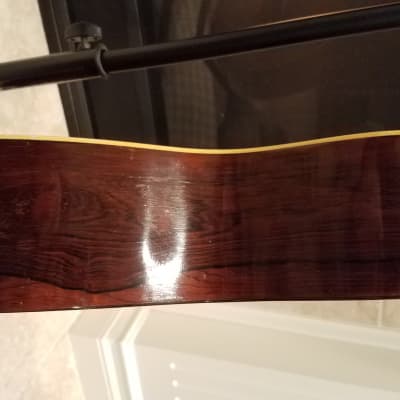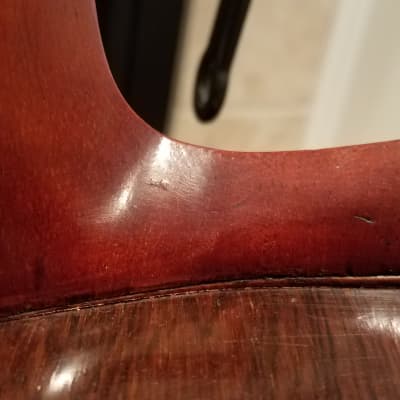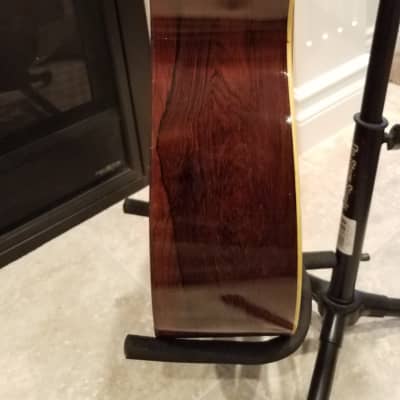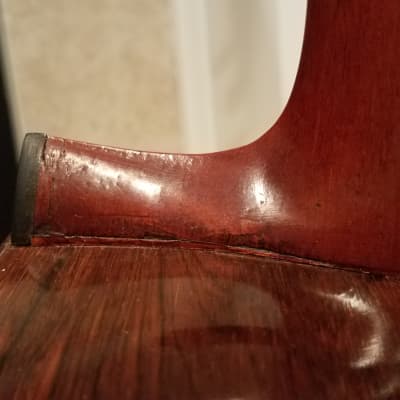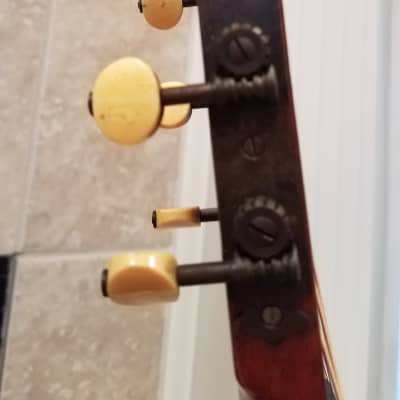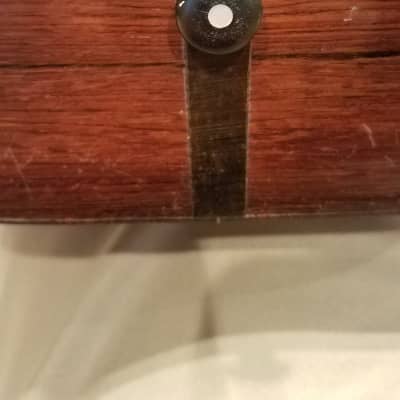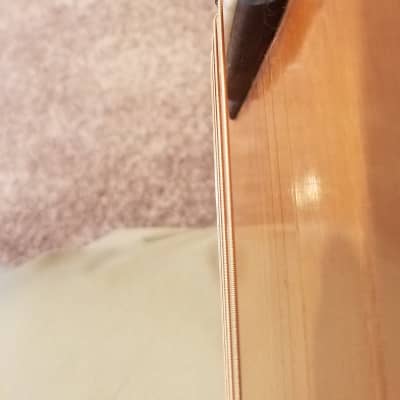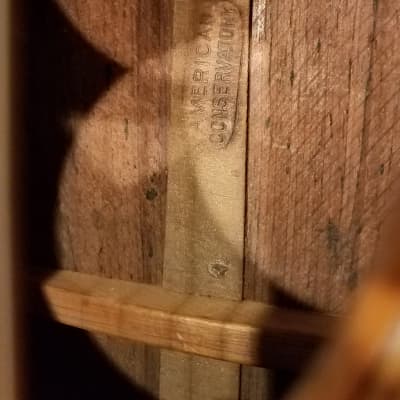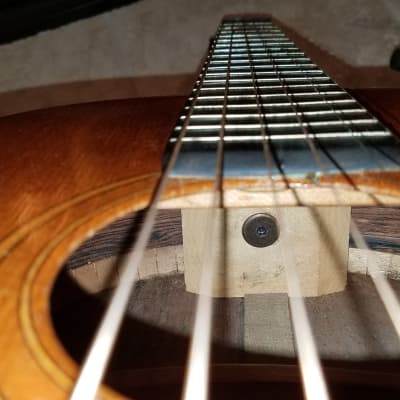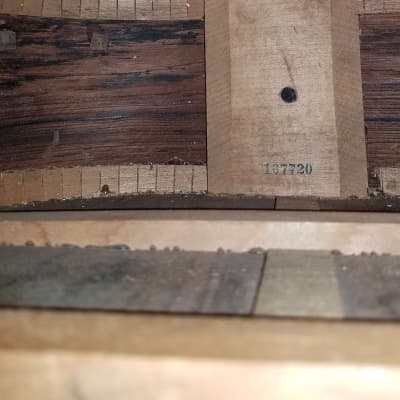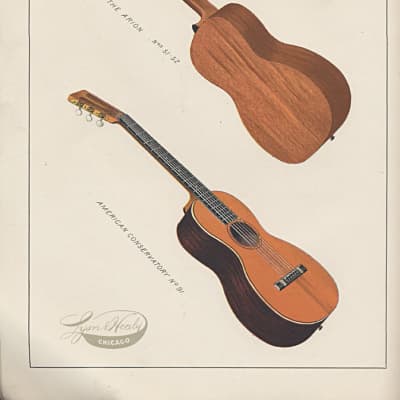Up for your consideration is an 1890's - 1900's Lyon & Healy American Conservatory model No. 91 parlor guitar, constructed of ladder-braced spruce over Brazilian rosewood.
Its appointments are very simple, but very pretty - a single-ply purfling on the top; double-ring wood rosette (the outer ring is 5-ply, the inner ring 3-ply); no headstock overlay; ebony nut, fretboard, bridge- and end-pins; and ebony heel cap. The tuners have very nice ivory knobs, and all are intact, amazingly with no cracks. The toner pegs are straight, and the tuners operate smoothly. The tuners, ebony nut, and ebony bridge- and end- pins are original; the bridge and saddle are customized replacements.
The neck is 12-fret to the body, with a slotted headstock and round inlays of MOP at 5, 7, and 9. The neck profile is what I would refer to as a 'modified V’, more rounded and 'D' shaped up near the nut, and becoming more of a true 'V' as you move up the fretboard. All one piece, of course.
With a nut-width of 1 3/4", and 2 5/16" spacing at the saddle, it is an excellent finger-picker / light strummer. Strung with Martin Silk and Phosphor (.011 - 47, 122 lbs of tension), and tuned to concert pitch, the action is just a little over 6/64ths at the 12th fret, with plenty of saddle remaining to lower further if desired. There is .015" relief in the neck. I like the Silk and Phosphor over Silk and Steel on these old ladder-braced guitars; I think it lends more bass and clearer trebles. This guitar sounds very mellow, yet punchy, with surprising volume and bass.
Cosmetically, it is in amazing shape for a 110 year old guitar. The back has numerous finish scratches, down to the wood, but NOT gouging it. The top has aged to a very nice amber, and aside from the repaired cracks (detailed below), is remarkably ding-free, aside from a very few pick scratches. There is some wear and minor dings on the edges of the peg-head, but the head, neck, and fretboard are similarly remarkably scratch or gouge-free. There is one very shallow dent, about 1'4" in diameter on the neck near the 3rd fret. The cracks had gathered dirt/grime over the years, and the repairs are slightly visible because of it, more so on the top than the back and sides. The fretboard has no fingernail divots, and negligible fretwear.
Aside from the 'American Conservatory' branded into the back seam support, I could find no markings other than the # 107720 in ink on the tailblock. There’s not a lot of online reference material, but I was able to find this exact guitar in an illustrated 1891 - 92 Lyon & Healy 'Catalogue of Musical Merchandise' in the Smithsonian archives, of all places. The last picture in this post is of that catalog page. The verbiage accompanying the illustration is:
"Shown in this catalog are a number of guitars, two of which are the "Arion" and the "American Conservatory" guitars. The "Arion" is made from several different types of wood, including solid mahogany, Brazilian cedar, and rosewood. The "Arion" guitar had a price range of $18.33 to $19.58. The "American Conservatory" guitar is constructed of rosewood and Brazilian cedar and has a stripe down the back. The guitar is "French Polished," which is a process of using shellac to give it a glossy finish. Though incredibly beautiful, this process of polishing wood tends to make it more susceptible to damage. The "American Conservatory" guitar, shown here, sold for $25. According to the catalog, the guitar "will not crack, warp nor shrink," and Lyon & Healy states that because they believe in "its absolute correctness we are prepared to stake our reputation.""
This has had a lot of love and repairs, and is now playable and ready for the next owner. When I rescued this guitar at a swap and sell show, I wasn't sure I'd get it to playable condition. The neck had been removed and a hack-job done in an attempt to reset it. The back had a sizable piece broken off, the bridge was rotted and cracked, and there was a long split in the side. The repairs are detailed below, shown in the pictures, and the guitar is now structurally sound. I performed all of the repairs myself, and while I’m not a professional luthier by trade, I have repaired/refurbished many guitars. I pride myself on well done repairs, and use Titebond Original glue.
- Repair of two soundboard cracks, one below the bridge and one above. The cracks are all well mated, and glued and cleated.
- Repair of two small cracks around the perimeter of the soundhole; also glued and cleated.
- Repair of a long split in the treble side, which extended from just above the 'waist', along the grain almost the way to the tail-block. A small splinter of the original wood was missing, and a piece of Indian rosewood has been spliced in place. this splice has no finish applied. I was very well pleased with the mating and alignment of this crack during the repair process, as it is difficult to accomplish on curved surfaces. The sides are well mated and aligned all along the length of the crack, and have been cleated with small rosewood cleats.
- Repair of a split in the ebony fingerboard that spanned the last several frets of the fingerboard extension. The repair is tight but the fingerboard extension is slightly depressed in this area.
- Repair of detached section of the back, on the bass side. This section was approx 4" wide, and extends from the rim, across 2 back braces, and ends with a jagged edge at approx. the midway point near the bass side 'waist'. The cracks are all well mated, and glued and cleated. The jagged edge sat proud of its mating surface, and has been sanded to level. This small area has no original finish, and can be seen in the close-up of the repaired area.
- The original bridge had lifted, split along the pinholes, and the ebony was really degrading. I removed and fitted a custom fit replacement. The bridge has been placed slightly back from the original footprint to improve intonation. The small exposed area in front of the bridge can be seen in the pictures.
- The bridgeplate holes had been thoroughly ‘chewed’ by a century of string replacements. Since the bridge plate runs the entire width of the guitar, and is part of the top’s support, instead of replacing, I’ve fit a bridgeplate overlay of 1/32” maple over the pinhole area only. The original bridge-pin holes have been plugged and leveled before the bridge replacement. The pinholes have been drilled and reamed to fit the original pins, and have been ramped and slotted. The plate and several of the cleats can be seen in one of the pics.
- Heel restoration and neck reset/conversion to a bolt-on neck. By this I mean that the neck had been removed, and too much material had been removed from the 'cheeks' of the heel where it meets the body. The result was a neck angle way too shallow. I had to apply tapered maple shims on either side to make up the proper depth and then adjust the angle.
- The heel portion of the dovetail joint had also been hacked away, so I've converted it to a bolt-on neck by inserted a machine threaded insert into the dovetail portion of the heel. A hole has been drilled through the heelblock for a threaded bolt to be inserted. The neck angle was then re-aligned/adjusted, and the fingerboard extension reglued to the top. The bolt can be seen in the picture of the heelblock through the soundhole. It is a tight and secure fit; instead of relying on shims in the dovetail joint to maintain a secure heel to body connection, the threaded bolt now draws the heel tightly to the body. Additionally, any future neck angle adjustments can be performed more simply.
- General setup including nut and bridge adjustments. There is no truss rod.
A note on 'action and playability': every guitar's action (
the string height at the 12th fret), relief (
the amount of forward curve of the fretboard), and playability (
the ease with which notes and chords are fretted) will be different depending on the guitar's setup. What is ideal for one person might not suit another, and any adjustment is understood to be the responsibility of the owner. The measurements and description I have provided are accurate and setup references are to my tastes, and may not be yours.
I have repaired and sold many guitars, and pride myself on my thorough description and customer service. The guitar will be packed securely, and shipped with insurance in a sturdy guitar shipping carton. Because of the repairs and investment I've put into this guitar (and that you won't have to), I am pricing this as what I believe to be fair, based the few comparable sales I have been able to find of similar era/style Lyon & Healy guitars. I will entertain reasonable Best Offer. I will offer FREE shipping with full purchase price; otherwise shipping and handling will be a flat $45 to the CONUS.
Please view all pics and ask any and all questions before buying/making an offer. I have described the condition accurately and completely; while I am certain you will be satisfied with the guitar,this is an as-is sale with no returns unless I have mis-represented something.

